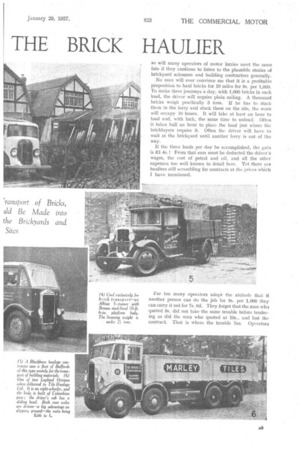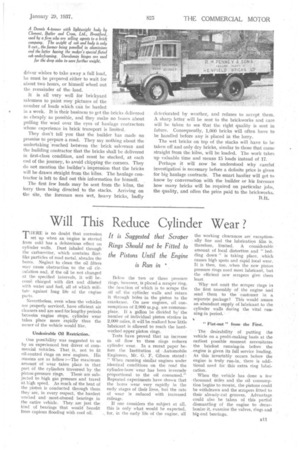SNARES THAT CATCH THE BRICK HAULIER
Page 42

Page 43

Page 44

Page 45

If you've noticed an error in this article please click here to report it so we can fix it.
MANY fortunes have been made out of common bricks since I hauled my first load back in 1910, but I have not heard of many being made by those who delivered the -bricks from the brickyards to the building sites, or by the men who work the clay, set the bricks, and later wheel them out, red hot, 5.0 at a• time, on metal-lined barrows.
Big profits have been made by brickyard companies and building contractors from 1910 to the end of 1936, and it cannot be denied that much of the profit has been. made out of the haulage contractors. The old, old story will still be used by the brickyard salesman and by subtle building contractors to induce hauliers to deliver bricks at definitely unprofitable prices, until such time as hauliers wake up to the fact that lorries cannot be rim on petrol, oil and air alone.
Makers do not sell bricks at pre-war prices, neither can the public purchase new houses at those figures. Houses that were sold at £500 in 1912 would fetch nearly £1,000 to-day, but bricks are being hauled at less than pre-war rates.
Bricks that, in 1012, were hauled by horsed carts on to sites four miles from the brickworks at a cost of is. M. per 1,000, are now being carried by motor lorries for a distance of 10 miles at 8s. per 1,000. Just as owners of horsed vehicles were hall ruined by the scandalous rates paid for brick haulage before the war, so will many operators of motor lorries meet the same fate if they continue to listen to the plausible stories of brickyard salesmen and building contractors generally.
No man will ever convince me that it is• a profitable proposition to haul bricks for 10 miles for 8s. per 1,000. To make three journeys a day, with 1,000 bricks in each load, the driver will require plain sailing. A thousand bricks weigh practically 3 tons. If he has to .stack them in the lorry and stack them on the site, the work will occupy .10 hours. It will take at least an hour to load and, with luck, the same time to unload: Often it takes half an hour to place the load just where the bricklayers require it. Often the driver will have to wait at the brickyard until another lorry is out of the way.
If the three loads per day be accomplished, the gain is 21 4s. From that sum must be deducted the driver's wages, the cost of petrol and oil, and all the other expenses too well known to detail here. Yet there are hauliers still scrambling for contracts at the prices which I have mentioned.
Far too many operators adopt the attitude that if another person can do the job for 8s. per 1,000 they can carry it out for 7s. 6d. They forget that the man who quoted 8s. did not take the same trouble before tendering as did the man who quoted at 10s., and lost the contract. That is where the trouble lies. Operators play into the hands of brickyard salesmen and builders, and do the work at the price suggested by them.
It is impossible to give a sate and proper price for brick haulage on a large scale (that is, for 100,000 bricks upwards) until the matter has been thoroughly investigated. The haulier will be well advised to visit the site of the building operations and use a little imagination. That will show him the difficulties likely to be experienced in driving heavily laden lorries around to the backs of ,the building sites. Will a good road be made for vehicles or will drivers have to keep their own track in sufficient repair? Is the lorry likely to waste valuable time on the site?
The contractor should have a chat with the foreman, and he will often find that, if he wants assistance on the site, he will have to ease one or two itching palms ! He will require .to know whether it will be permissible to tip the bricks, or whether they will have to be stacked. Some foreman bricklayers are " touchy " on the question of bricks being tipped. The difficulty, as I have hinted, can be overcome, but where gratuities have to be paid care must be taken in allowing for them when quoting. Again, inquiries must be made at the brickworks. Has the lorry to
take its chance in securing loads? Will it have to Wait its turn, or has the brickworks a huge stack of bricks from which lorries can load from without waiting? The haulage contractor will require to be in the " good books" of the brickyard foreman. It will make a big difference to the loads that can be carried in a week if the lorry driver knows that he can always have a couple of men to help him to load at the brickyard and ample assistance on the site.
Not all the bricks will be drawn from the stacks. Some of the loads will have to come from the kilns, andin this connection the contractor will need to make careful inquiries. It may be that the roads leading to the kiln are narrow. It may be that lorries have to back out, or wait half an hour for brick-yard trolleys to be unloaded, or the bricks may have to be wheeled an appreciable distance. An hour is easily wasted in this way.
When drawing from a kiln the bricks are often red hot and considerable damage may be caused to lorry bodies. A metal-lined body is desirable, a metal floor possessing the additional advantage of facilitating the tipping of bricks. Often, when the bricks are hot, the brickyard employees refuse to handle tbern until they cool down. If the lorry
driver wishes to take away a full load, he must be prepared either to wait for about two hours, or himself wheel out the remainder of the load.
It is all very well for brickyard salesmen to paint rosy pictures of the number of loads which can be hauled a in a week. It is their business to get the bricks delivered as cheaply as possible, and they make no bones about pulling the wool over the eyes of haulage contractors whose experience in brick transport is limited.
They don't tell you that the builder has made no promise to prepare a road. They say nothing about the undertaking reached between the brick salesman and the building contractor that the bricks shall be delivered in first-class condition, and must be stacked, at each end of the journey, to avoid chipping the corners. They do not mention the builder's impression that the bricks will be drawn straight from the kilns. The haulage contractor is left to find out this information for himself.
The first few loads may be sent from the kilns, the lorry then being directed to the stacks. Arriving on
the site, the foreman sees wet, heavy bricks, badly
deteriorated by weather, and refuses to accept them. A sharp letter will be sent to the brickworks and care Will be taken to see that the right quality is sent in future, Consequently, 1,000 bricks will often have to be handled before any is placed in the lorry.
The wet bricks on top of the stacks will have to be taken off and only dry bricks, similar to those that come straight from the kilns, will be loaded. The work takes up valuable time and means 15 loads instead of 17.
Perhaps it will now be understood why careful investigation is necessary before a definite price is given for big haulage contracts. The smart haulier will get to know by conversation with the builder or his foreman how many bricks will be required on particular jobs, the quality, and often the price paid to the brickworks.
B.H.




















































































